Gays, let’s rally! I’m here, queer, and ready to dive real deep into a very important dyke media legacy: queer cheerleaders on screen.
I made a list of all the pom-pommed lesbian and bisexual moments from film and television I could think of off the top of my head, which it was already very long! I then researched further and uncovered even more. The Queerleader has long been an image used to both subvert and reinforce notions of girlhood and femininity. As with many tropes and stocktypes when it comes to queer images and stories in film and TV, the Queerleader is complicated: sometimes a powerful image of femme lesbianism and other times intentionally portrayed as disruptive and dangerous, a threat to not only men but the women in close proximity to her.
Before we get into the timeline, let’s start with the roots of the Queerleader’s legacy.
What makes the sport and spectacle of cheerleading a realm so rife with lesbian and bisexual activity? Well, I think the answer is as simple — and as complex when you really drill into it! — as the answer to why settings/contexts such as all-girl’s schools, convents, and sororities are also frequent playgrounds for queerness and sexual exploration. These are, conventionally, highly feminized spaces considered to be largely free of men. And that’s where things also get complicated, because such spaces are often fetishized by straight cis men for that exact reason. It is a place where they are forbidden, and therefore it’s a place where they cast their voyeuristic gaze, peering as if through a peephole. You might not be surprised that when researching this specific topic, I also encountered a lot of cheerleader-themed lesbian porn.
But I think it’d be overly simplistic — prudish, even — to suggest the Queerleader and the homoeroticization of these other “feminine” spaces exist solely for the male gaze. It’d be a stretch to suggest straight men invented the Queerleader, even if the earliest examples of these filmic depictions were indeed constructed by men. While those might compose the majority of our pre-1999 examples, I think that has more to do with who had the means and power to make movies. There are lots of early- to mid-twentieth century examples of women writing lesbian narratives set in some of the aforementioned women’s spaces, including 1917’s Regiment of Women by Clemence Dane, set at an all-girls school. Radclyffe Hall drew from her friend Toupie Lowther’s experiences in a French World War I women’s unit for her famous novel The Well of Loneliness (1928). Prolific lesbian pulp novelist Ann Bannon realized her own sexuality while in a sorority in college and then went on to write Odd Girl Out (1957) about two sorority sisters in a relationship.
Sure, these are examples from literature, but in the early- and mid- 20th century, literature was a more accessible artform than film/television for women and queer people, especially because pen names allowed them to write somewhat anonymously and ambiguously. But on the cinematic side of things, Dorothy Arzner arguably invented the all-girls school film with The Wild Party in 1929, and while the movie features pre-Code compulsory heterosexuality, its lesbian erotics are impossible to miss.
So, cheerleading does seem to fit into this concept of “women’s spaces,” which make for ideal settings for lesbian narratives — especially in decades when homosexuality was widely criminalized and stigmatized — by allowing women to be in close proximity to each other. These are worlds in which women touching and being physically close can be seen as normal and even expected and not strictly forbidden or policed.
But when it comes to the Queerleader, I do think the reoccurrence of this image goes beyond cheerleading being a largely women-dominated sphere. At the risk of starting to sound like an academic paper (or perhaps that line has already been crossed lol), I argue that the cheerleader is an ideal symbol to inject with or project upon queerness due to the dichotomies cheerleaders have long culturally represented. In Go! Fight! Win!: Cheerleading in American Culture, Mary Ellen Hanson digs into these contradictions embodied by cheerleaders:
The cheerleader is an icon, an instantly recognized symbol of youthful prestige, wholesome attractiveness, peer leadership, and popularity. Equally recognized is the cheerleader as a symbol of mindless enthusiasm, shallow boosterism, objectified sexuality, and promiscuous availability. (Hanson, 2)
Indeed, cheerleaders are largely considered the most popular girls at school while simultaneously dismissed as vapid, empty-headed dolls. They’re portrayed as Good Girls who cheer on the boys but they’re also portrayed as scantily clad seductresses. Their femininity is a weapon and a beacon.
I’ll never forget the time a friend rudely dismissed another woman I barely knew and, when I asked why she’d done so, she simply said “she was a cheerleader in high school.” This ex-friend was parroting very common (and boring!) assumptions about cheerleaders that have been around for forever. She sounded not unlike this snide 1974 Esquire article about ex-cheerleaders, but it was 2014. (That Esquire article replicates additional persistent cultural expectations of cheerleaders, including that they be white, blonde, and have an ass in a manner that could read as tongue-in-cheek but is most certainly not.)
Do these dichotomies and paradoxes not sound familiar? Are they not evocative of the ways lesbians are also culturally regarded and portrayed throughout history? Simultaneously sexless and hypersexual. Queering the cheerleader becomes a way to both challenge and reify these dual narratives. Homophobic iterations of the Queerleader see her as a predator and an affront to the feminine ideal cheerleaders are meant to symbolize. But positive and queer-created iterations of the same character ultimately capitalize and play on the same assumptions and cultural symbols. The most successful and compelling ones just do so in a way that confronts those ideas rather than merely replicating them.
When I started writing this piece several months ago, I mostly meant for it to be, well, horny. Horny, funny, and detailed — my sweet spot! Now this final iteration has, like, lite citation work???? But listen I, not unlike a Queerleader, can be many things at once. Please let me live my best erotic-meets-scholarly life. Reference work can be horny, too!!! I’m engaged to a librarian after all.
And with all that context, here’s my painstaking timeline of the Queerleader in film and television.
This post was originally written in January 2023 and updated/republished in September 2023.
1970s: The Sexploitation of Lesbian Cheerleaders
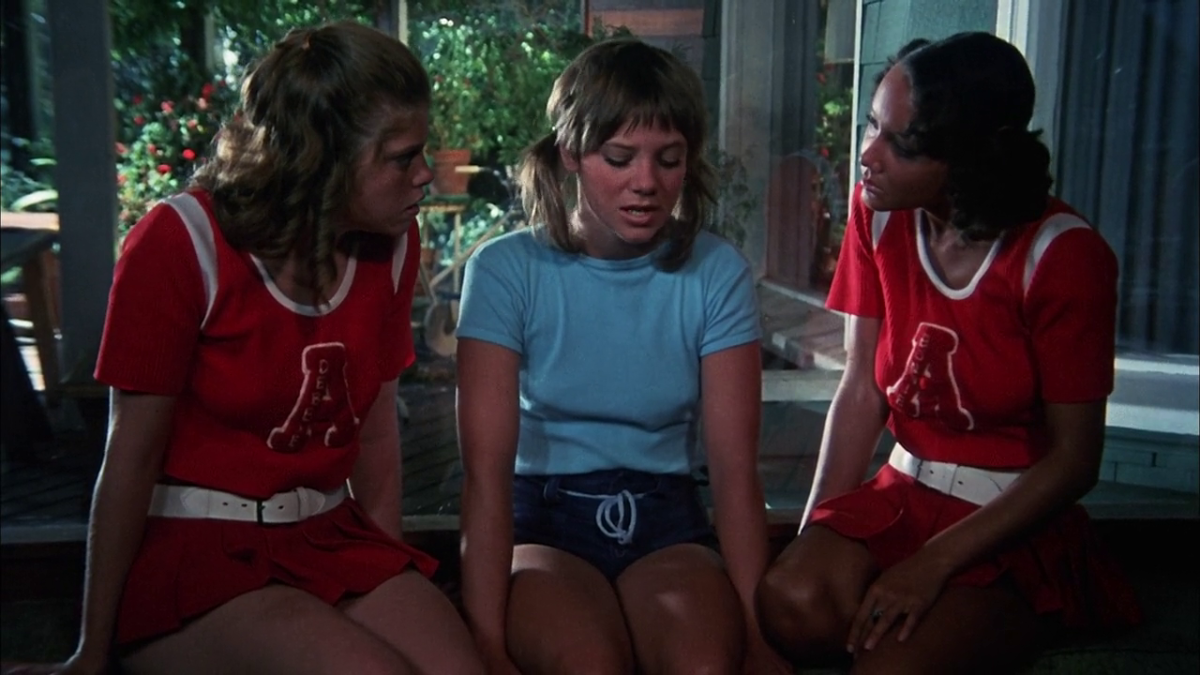
I tried very hard to find some readily available pre-Code films that 1. featured cheerleaders in a significant role and 2. had enough legible lesbian subtext to warrant a place in this timeline, but this proved difficult! Once I researched the actual history of cheerleading itself, the reason became clear.
Cheerleading has not always been a women-dominated sport. In fact, it was mostly for men prior to WWII. This makes sense, as cheerleading started at the college level in conjunction with intercollegiate sports. In the late 1800s and early 1900s, male volunteers would lead cheers to encourage spectator involvement during sporting events (Hanson, 11).
Stunts and jumps started becoming more popular in the 50s, and then the 70s saw the introduction of Title IX, which expanded athletic opportunities and funding for women’s sports. Cheerleading increasingly became more athletic and less about just shouting from the sidelines as a result. So, that’s your little mini history lesson on cheerleading and likely the reason why we don’t see a lot of filmic representations of women cheerleading in the pre-Code or Hays Code eras of Hollywood.
The first real instances I found of cheerleaders engaging in lesbian activity were the aforementioned 70s sexploitation movies in which hookups between women are used mostly as non-sequitur titillations. The Cheerleaders (1973) — in which high school cheerleaders decide to sleep with the rival team’s players so that they’ll be too tired to play well — and the absurdly titled The Great American Girl Robbery (1979), about a bus of cheerleaders taken hostage, were the most overt examples of these.
As that aforementioned Esquire article published in 1974 shows, the idea of the cheerleader as a sex symbol was already firmly in place during this decade, and it’s not at all shocking that we see Queerleaders cropping up in these soft core movies. I cannot in good conscience recommend these two particular films, but the lesbian sex scene in The Cheerleaders that prominently features an exercise bike is…very memorable! If you’ve seen any 70s-era titty movies, there’s nothing here that will shock you too much.
But I’m a Cheerleader (1999)
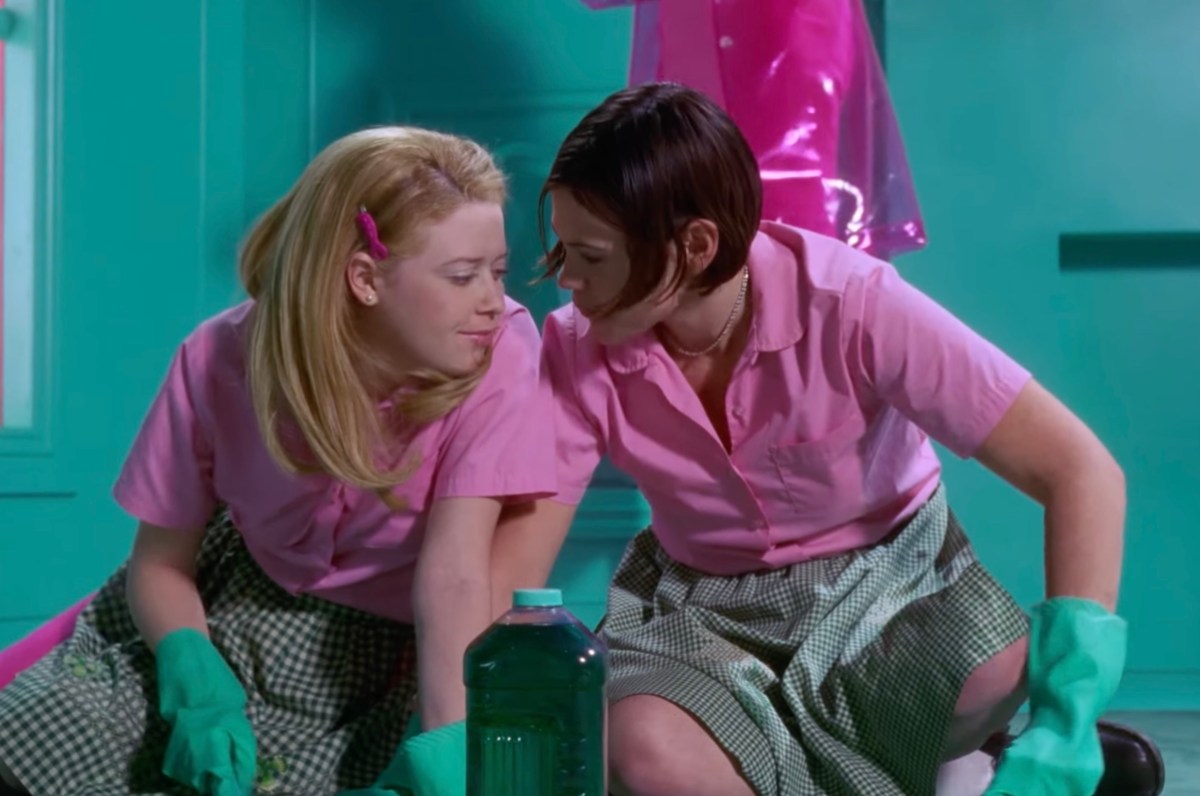
Jamie Babbit’s satirical teen film starring Natasha Lyonne and Clea DuVall as friends-turned-lovers at a gay conversion camp is easily the most iconic entry on this list — and arguably the prototypical Queerleader Movie even if technically some depictions do predate it. But given that Babbit is queer herself, this feels like the true beginning.
In an interview in 2005, Babbit had this to say about the decision to make the lead character a cheerleader:
Well, the reason we wanted to have the lead character be a cheerleader is because, for us, it was sort of the pinnacle of the American dream, and the American dream of femininity.
Babbit utilizes and flips the same image and assumptions those 1970s sexploitation movies with Queerleaders also put forth — but in a way that’s distinctly queer and subversive. Those 70s movies assume that a cheerleader engaging in lesbian sex is inherently horny (and mainly for straight men) because it seems forbidden and wrong in the context of the All-American Good Girl the cheerleader has come to represent. Cheerleaders exist, by the definition adopted by those movies, to root for and devote themselves to men and men’s accomplishments. To see them having sex with each other (even with the secret presence of a male voyeur, as those 70s scenes tend to involve) is at odds with that. With But I’m a Cheerleader, the primary intent is not necessarily titilation, but there’s something similarly fraught in how Megan’s queerness is considered at odds with her identity as a cheerleader. Even its tongue-in-cheek title nods to this: She can’t be gay because she’s a cheerleader. Only here, Babbit is indeed making fun of such a silly declaration, challenging not only the dominant narrative of how queer women look and act but also of how cheerleaders act, too.
The movie is not just one of the best and earliest Queerleader texts but also one of the greatest lesbian films of all time; in fact, it’s in the number one spot on our list of the 200 best lesbian, bisexual, and queer films.
Bring It On (2000)
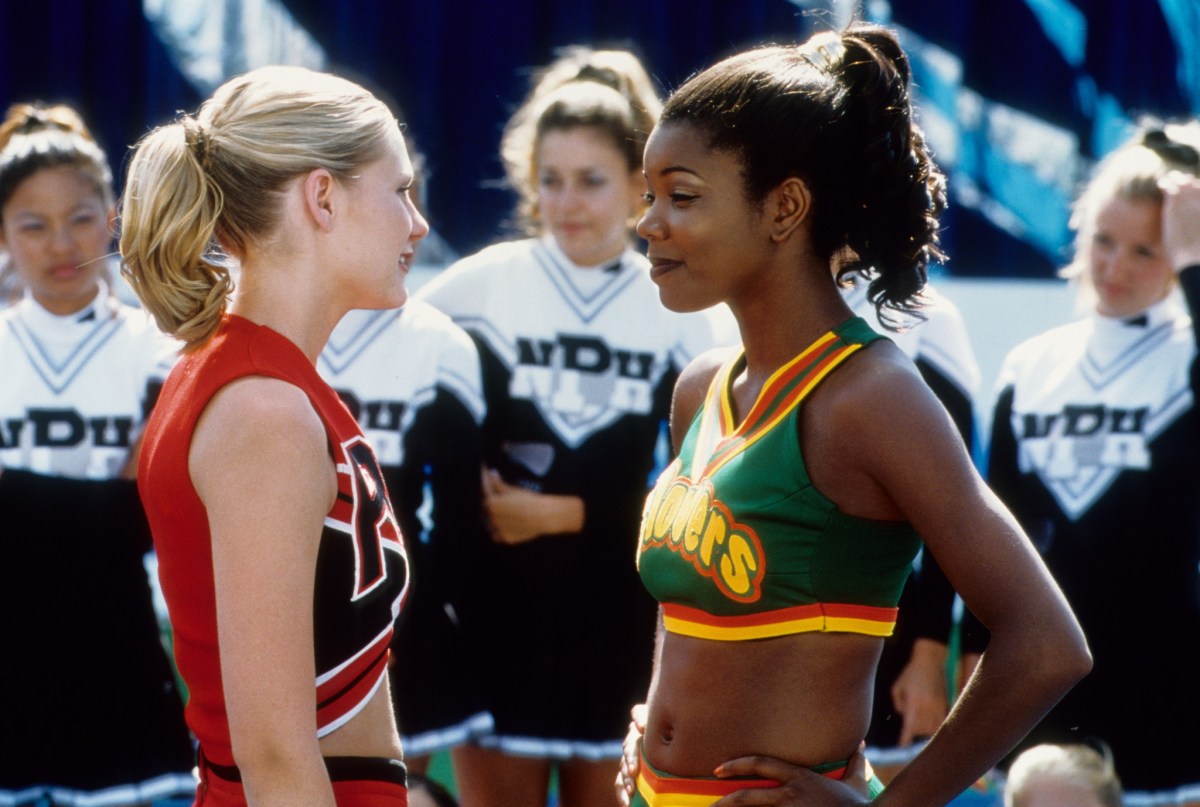
This movie is the only one in this timeline that employs lesbian subtext rather than explicitly queer content, but it’d be silly to ignore Bring It On‘s ongoing popularity in the dyke community, especially since a lot of us who are over 30 and often clung to movies in our younger years that were not necessarily loudly queer but had an implied lesbian undercurrent to them (because some of us ourselves were not necessarily loudly queer but had an implied lesbian undercurrent to, like, every movement we made). Bring It On might not be an official Queerleader text, but it is almost too easy to project a Queerleader narrative onto it.
Bring It On, a very good movie, also inspired an entire multiverse of very bad straight-to-video/made-for-TV movies, and you’ll read a little more about that further down the timeline.
Veronica Mars, “Versatile Toppings” (2006) / Heroes, “Hysterical Blindness” (2009)
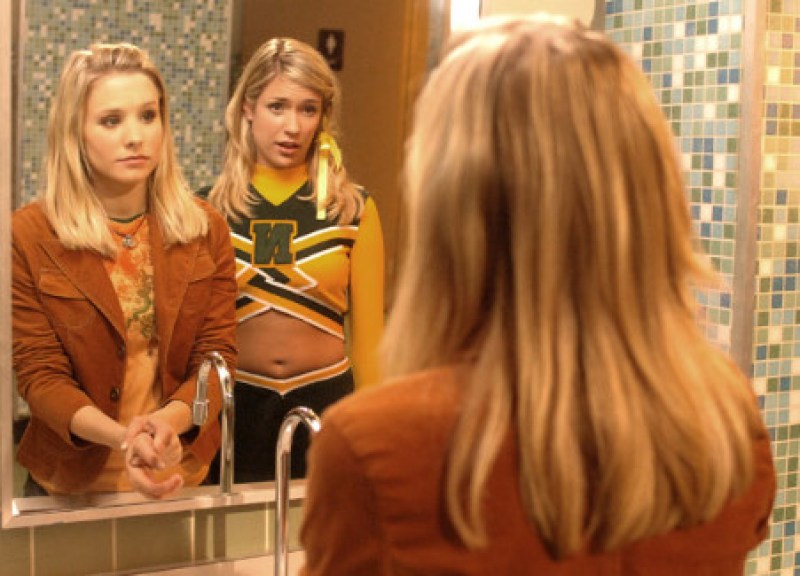
Season two of Veronica Mars gave us gay cheerleading activity in the episode “Versatile Toppings,” which is, unfortunately, a reference to pizza and not to lesbian tops. The episode feels like a 2006 pop culture time capsule in that it stars Kristin Cavallari of Laguna Beach fame as a closeted cheerleader. There’s also some throwback high school homophobia on display, with Madison Sinclair taunting another closeted character, Marlena, for looking like an Indigo Girl? Anyway, while lesbian cheerleading isn’t exactly a main throughline of this show or even this episode, I’m interested in how the Queerleader trope’s appeal and ubiquity makes it so that it even shows up in small moments like this. We see another quasi-instance of this in the fourth season of Heroes, which manages to combine Queerleader and Sapphic sorority shenanigans. Sure, Claire is no longer a practicing cheerleader at this point, but her college roommate’s obsessive crush on her does seem to hinge on a romanticization of the All-American girl aesthetics that Claire gives off. I’m counting it!
Degrassi: The Next Generation (2006)
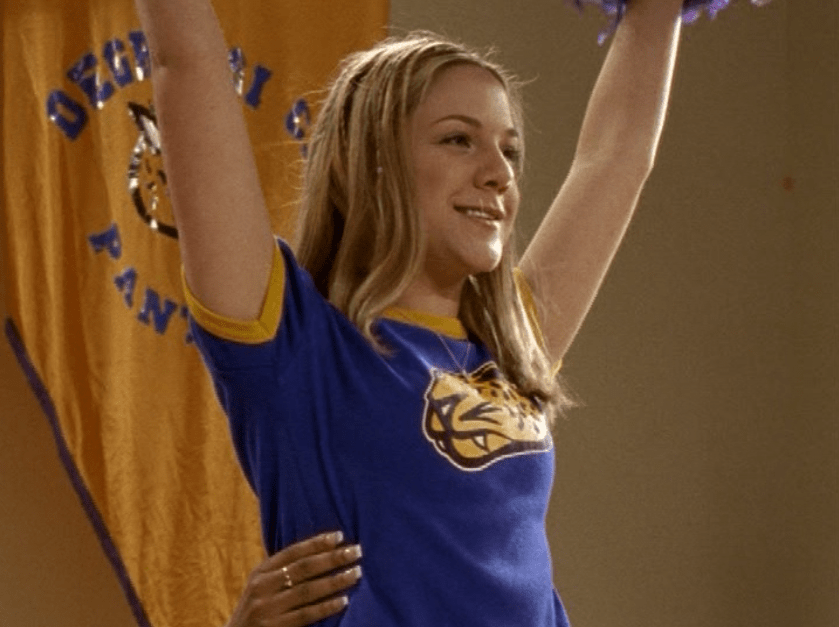
Paige Michalchuk (Lauren Collins) is arguably television’s prototypical Queerleader. She first comes to terms with her bisexuality in season five, beginning a relationship with Alex Nuñez (Deanna Casaluce) in “The Lexicon of Love (2).” They have a classic enemies-to-lovers + opposites attract trope trajectory: Paige is the school’s Queen Bee and a popular cheerleader, while Alex is considered a “bad girl” from “the wrong side of the tracks.” They both have more layers to them than these stocktype categories suggest. It’s easy to interpret Paige’s attraction to Alex as directly connected to the fact that she’s different than the other girls Paige tends to associate with. A quick tumblr search reveals their ship portmanteau “Palex” is still popular to this day, and I found a few different fanfics that explicitly make use of Paige’s cheerleading uniform to erotic effect.
It’s quite easy to draw a line from Paige to Glee‘s Santana Lopez.
Across the Universe (2007)
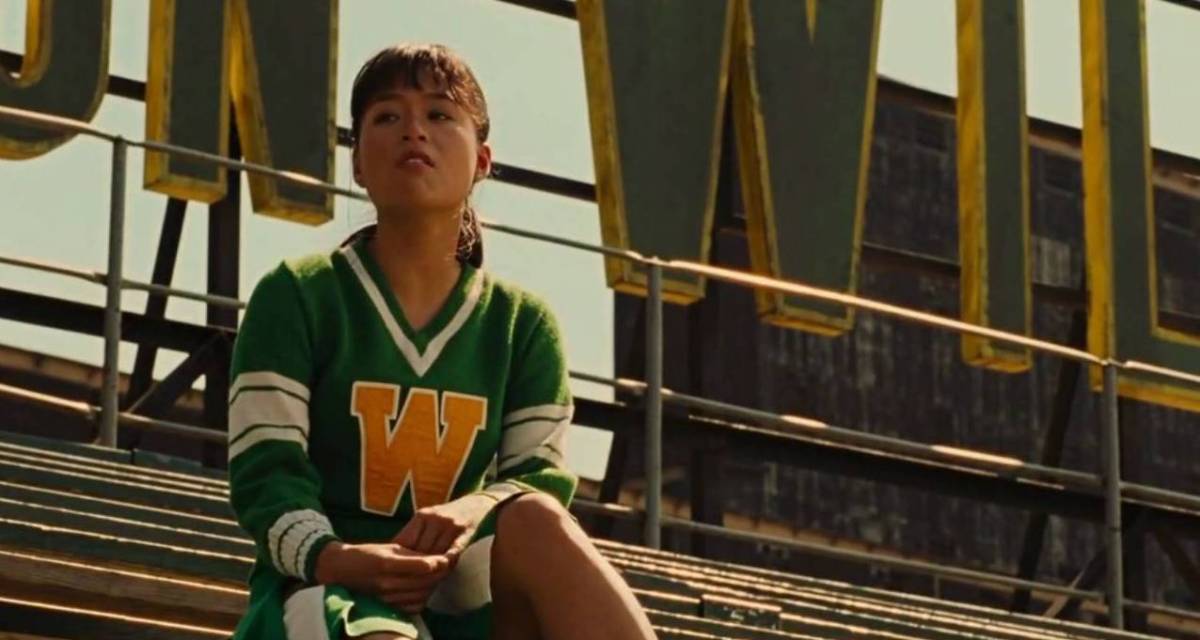
The chokehold this Beatles-themed musical movie had on me when I was 15 and in performing arts school? Impossible to overstate. Though I was too closeted at the time to admit it, a big component of this obsession was the movie’s recontextualization of the song “I Want To Hold Your Hand” to be about a closeted cheerleader’s queer longing. Prudence holds it down for all the small-town Midwestern queerleaders out there. Played by Chinese American actress T.V. Carpio, she also stands out on this list, which incidentally tracks how a lot of on-screen portrayals of cheerleading default to whiteness. After all, queerleaders are known for being many things at once, and oftentimes characters of color are not allowed to be as complex and contradiction-laden as their white counterparts.
Jennifer’s Body (2009)
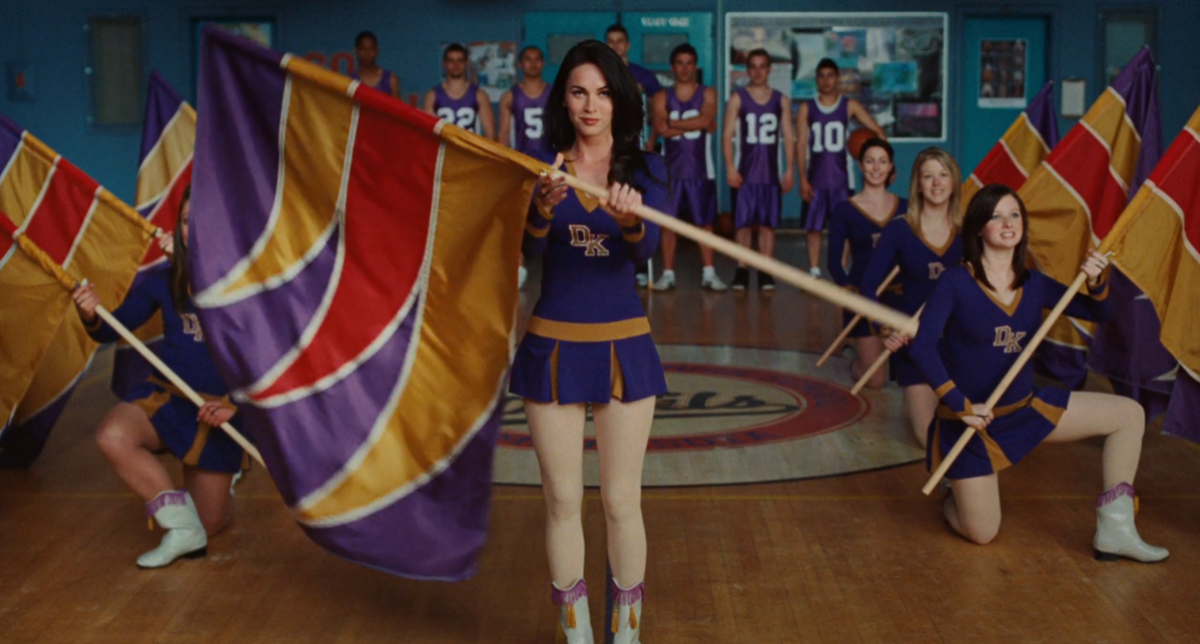
Underrated — and even maligned — at the time of its release and now accepted and celebrated as a classic after many years of cultural writing that has reconsidered and reframed the conversation around it, Jennifer’s Body is one of the best bisexual horror movies ever made. It was, by my memory, the first time I saw two women kiss on the big screen.
But even before that, Jennifer’s Body stirred within me some sort of feral animal force. It wasn’t the jumpscares or the body horror that got me; the thing that made me want to shut my eyes was the sexual tension between Needy (Amanda Seyfried) and her best friend Jennifer (Megan Fox). It was too much for my closeted self to bear. In their first scene together, Needy watches Jennifer do a routine in her cheerleading uniform — in slow motion — in the high school gym. Perhaps the slow motion is intended for the viewer’s own voyeurism, but my reading is that this is Needy’s perspective; she sees Jennifer’s body (*Beanie Feldstein voice* it’s the TITULAR ROLE) in aching, softened, sexy motion, so that’s what we see, too. She watches so closely, so intently, and with such unfiltered desire registering in her gaze that another student actually leans forward and says “you’re totally lesbi-gay.” To me, this entire moment is far more erotic than their eventual make out.
This is less a movie about cheerleading and more a movie about Jennifer turning into a flesh-eating succubus, but given that opening scene’s slowed-down, cheer uniform-clad, “lesbi-gay” iconic visuals, it’s an important film in this timeline. Jennifer’s status as a popular cheerleader is a big part of why she’s able to get close to men and subsequently kill them. She threatens natural social order at their school not because she’s maybe in love with her best friend but because she’s… a literal demon.
Fired Up! (2009)
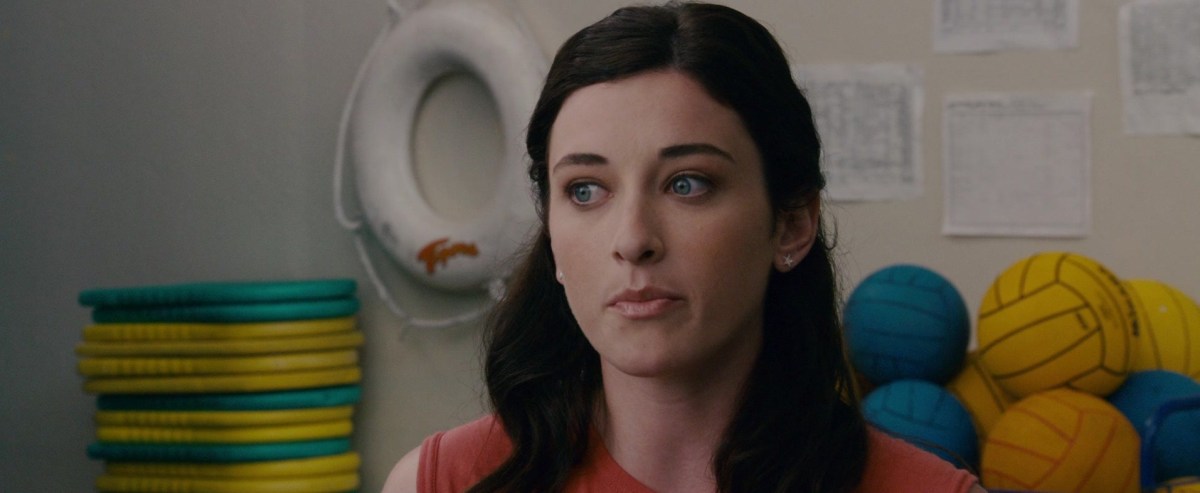
Do I regret the hour and a half I spent watching this movie? Mostly! Was it perhaps worth it for the scene where all of the attendees of a cheer camp recite lines verbatim in unison while watching Bring It On? NOT QUITE. Fired Up! is about two football dudes who decide to go to cheerleading camp in order to up their body counts, so perhaps you will not be surprised to learn that the humor here is of the crude, bro-y sort.
The only Queerleader in this movie is a textbook example of a predatory lesbian, and I almost didn’t include it in this timeline for that reason. But I ended up wanting this exploration to feel really comprehensive and layered, and that means including the bad shit, too.
There’s a running gag in the movie that one of the airhead cheerleaders doesn’t realize the Queerleader is aggressively hitting on her. Fired Up! positions the Queerleader as an impure perversion of the cheerleader, as a stark deviation from what Fired Up! believes cheerleaders should represent. In a way, there’s even a parallel between her and the straight dude protagonists, whose proximity to cheerleading is predicated on them just wanting to have access to cheerleaders and their bodies. Only, the guys get to be the goofy and ultimately redeemable protagonists, while she remains a bit character we’re meant to think is gross.
Fired Up! came out when I was in high school, and I don’t think I saw it at the time, but this was an image of lesbianism I was very familiar with, and it’s actually this sort of casual representation of the lesbian as inherently creepy and aggressive within feminine spaces that did way more psychic damage on me than any overt examples of the lesbian as a villain or even as a killer. Remember how I wanted to shut my eyes during the opening cheerleading scene of Jennifer’s Body? It was exactly because of this; because I felt like a creep for looking at her the way Needy does.
Fun Fact: There’s a blooper reel during the credits, and in it Juliette Goglia’s Poppy — who is one of the main guy’s little sisters — actually says the word Queerleader during a runner of various alternative punchlines. It’s absolutely meant as an insult in this context, but again, I’m looking at alllllll filmic representations of this topic, baby! The good, the bad, and the ugly!
Glee (2009)
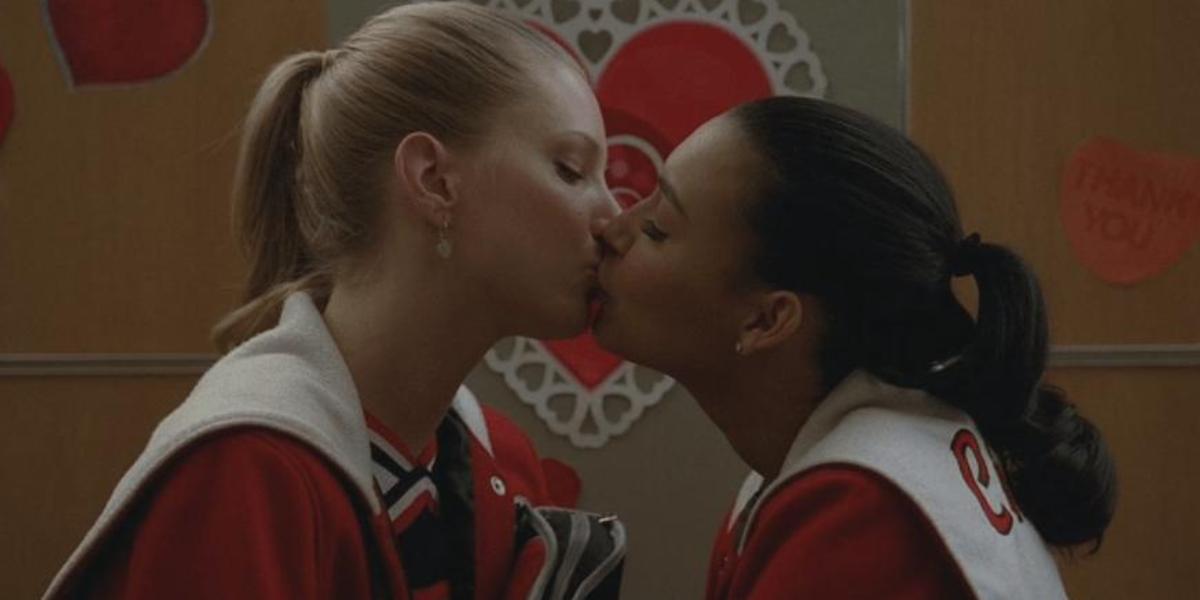
Ah, yes, if Across the Universe had a chokehold on me when I was a musical theater student in high school, well, Glee tightened that grip even more. Though about a glee club first and foremost and only sometimes about cheerleading by way of its central villain Sue Sylvester (Jane Lynch, unfortunately not playing a queerleading coach), the image that comes to mind most readily and potently when I think of Glee is this: two girls in cheerleading uniforms, holding pinkies.
Santana Lopez (Naya Rivera) and Brittany Pierce (Heather Morris) were formative queerleaders for me — and arguably they are THE Queerleaders in this timeline. The first time we ever see them kissing, they’re in bed together in their cheerleading uniforms. Those uniforms are inextricable from these characters. Brittany’s bisexuality isn’t really a source of conflict, and Santana’s whole thing is that on the surface she’s the prototypical Mean Girl trope but then there’s so much more to her. Indeed, she’s mean to just about everyone except Brittany. And they go from high school sweethearts to wives!
Fun Fact: One of the gayest things I ever did when still identifying adamantly as straight was when I wrote an “article” for a “pop culture zine” on my college campus about the merits and nuances of Santana Lopez’s coming out arc on Glee.
Hellcats (2010)
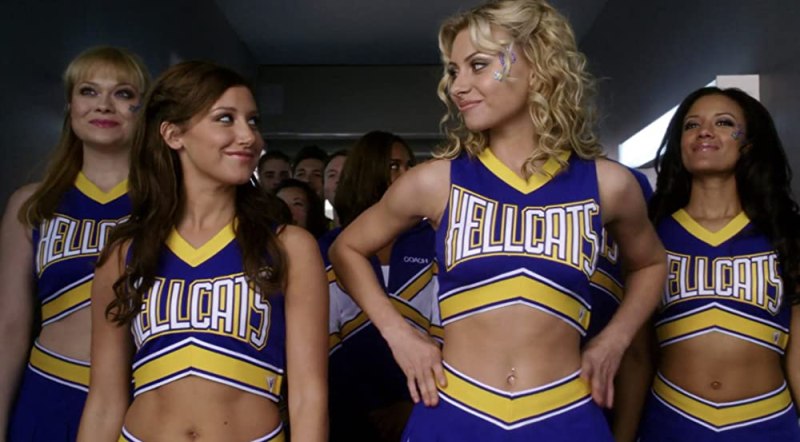
This series about college cheerleaders only ran on the CW for one season and is nearly impossible to stream these days. But during that brief run, Elena Esovolova played Patty “The Wedge” Wedgerman, an out lesbian on the squad. However, Patty only appeared in five episodes and never really got a fully fleshed out storyline. Despite having a lesbian character, there are no lesbian relationships in the series, and if anything the gayest parts actually seem to be the subtext between the show’s main characters Marti (Aly Michalka) and Savannah (Ashley Tisdale).
Apparently during a press tour in 2011, Michalka noted that Patty had been dropped from the narrative because the writers “found that it was really hard to involve her with the Hellcats and dividing all the story lines.” While supposedly Michalka noted this had nothing to do with Patty being a lesbian………….I’m not convinced. It sounds to me like another instance of the Queerleader rendered an “outsider,” and instead of that becoming a meaningful and potentially even powerful image dismantling ingrained images, it becomes an inconvenience for the writers. I genuinely enjoy lesbian subtext, but if you’re only willing to go there and not into more explicit queerness WHEN THERE IS ALREADY A LESBIAN CHARACTER AROUND, that’s a no for me.
All Cheerleaders Die (2013)
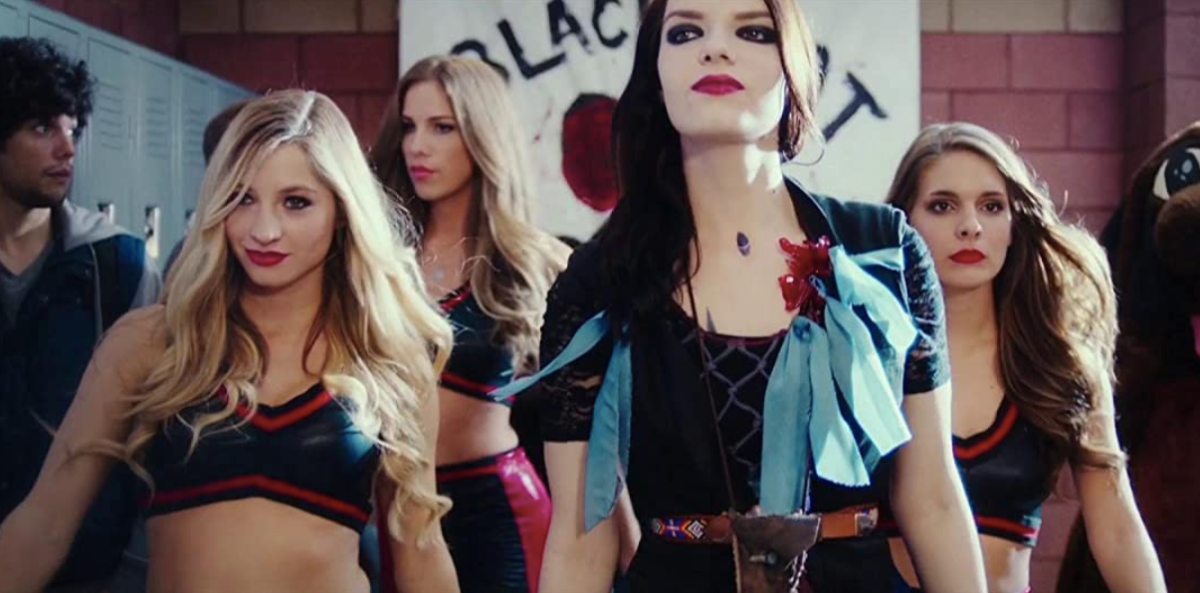
I watched this movie for the first time recently and was quite delighted by it! Is it perfect? No. But it’s fun horror trash with occasionally glimmers of brilliance. All Cheerleaders Die centers on Mäddy (Caitlin Stasey), a girl whose best friend dies during a cheerleading stunt gone wrong. (The found footage-style scene that establishes that death at the beginning of the movie is fantastic; I always love portrayals of cheerleading that acknowledge just how brutal the sport can be, which we’ll get into further down the timeline.) The following year, Mäddy joins the squad, which is very confusing to her recent ex-girlfriend Leena, who btw is a witch.
When an altercation with the football team leads to the cheerleading squad’s deaths, Leena brings them all back from the dead. The catch? They’re basically linked succubus/vampire-like creatures who have to collectively feed on men’s blood to maintain their strength. There’s body-swap shenanigans, body horror, all my favorite things. All the while, Leena seems to get a very kinky pleasure out of basically being in charge of the lives of these cheerleaders. And like a good monster lover, she lets Mäddy feed on her.
A double-feature screening of Jennifer’s Body and this movie would be very fun! I like my Queerleaders to be murderers of men!
Wynonna Earp, “Gonna Getcha Good” (2017)
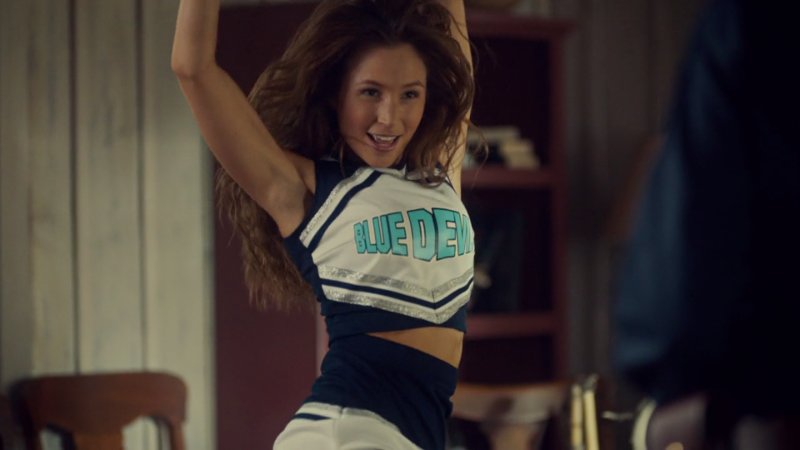
In season two, episode three of the beloved sci-fi Western series Wynonna Earp, bisexual character Waverly (Dom Provost-Chalkley) dons a cheerleading costume and puts on a seductive routine for her girlfriend Nicole (Katherine Barrell). This show isn’t even a little bit about cheerleading, but this is a very important Queerleader moment in that Waverly is explicitly doing cheerleader roleplay to turn on her girlfriend. The scene directly acknowledges the erotic appeal of cheerleading for lesbians and bisexual women.
“I didn’t know if it was your thing,” Waverly says after she’s done with the cheer. Nicole’s jaw is on the floor. “Baby, that’s everybody’s thing,” she says. Which is basically my entire thesis for this piece in a nutshell.
Riverdale (2017)
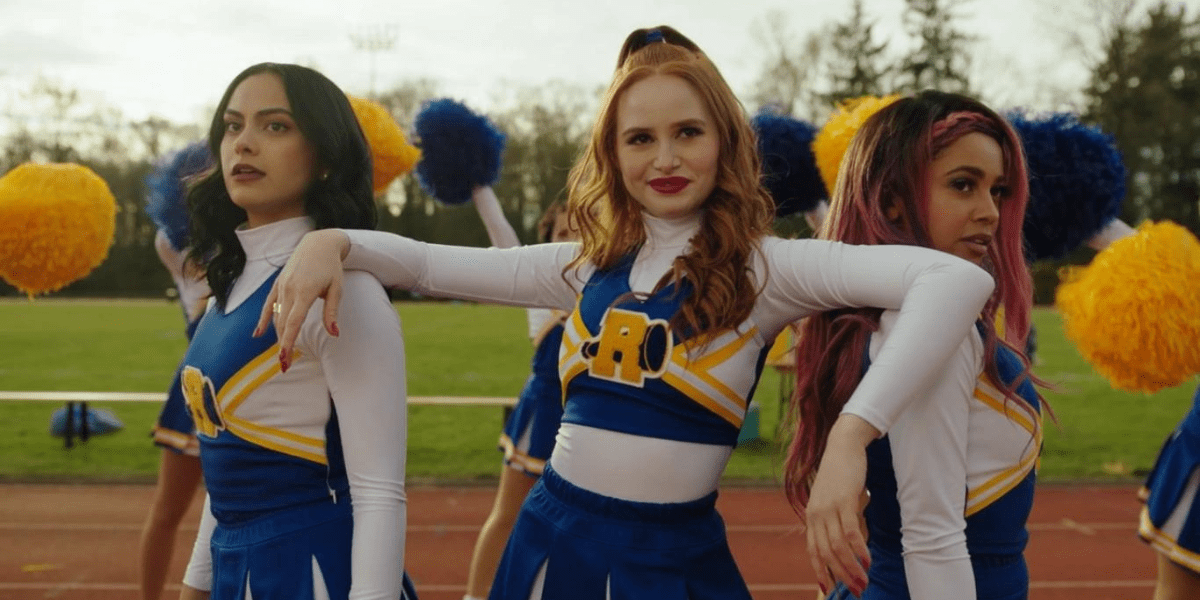
Season two of Riverdale saw the official introduction of queer storylines for Cheryl Blossom (Madelaine Petsch), but some of us ahem SCHOLARS were picking up on the gay vibes emanating off of the red-haired and sharp-tongued cheerleader since basically episode one.
Indeed, Riverdale‘s pilot actually features a Queerleader moment — a kiss between Veronica (Camila Mendes) and Betty (Lili Reinhart) during their Vixens tryouts that Cheryl immediately dismisses as pandering and dated: “Faux lesbian kissing hasn’t been taboo since 1994.” But later in the series, Cheryl goes on to co-captain the Vixens with her literal girlfriend, the bisexual icon Toni Topaz (Vanessa Morgan). I strongly believe Cheryl is evidence of Santana Lopez’s lasting Queerleader impact. Here, too, is an on-the-surface Mean Girl stocktype who actually harbors a quiet vulnerability and softness in her, brought out by the fellow Queerleader she falls in love with.
In the final season of Riverdale, the characters are transported back to the 1950s and in high school again. In addition to on-and-off Vixens Betty and Veronica finally becoming canon — recontextualizing that kiss from the pilot — the series ends with Carol and Toni coming out as a couple to their fellow Vixens and a few of the other cheerleaders also coming out in response. Queerleading is inextricably baked into the wild world of Riverdale.
The Babysitter (2017)
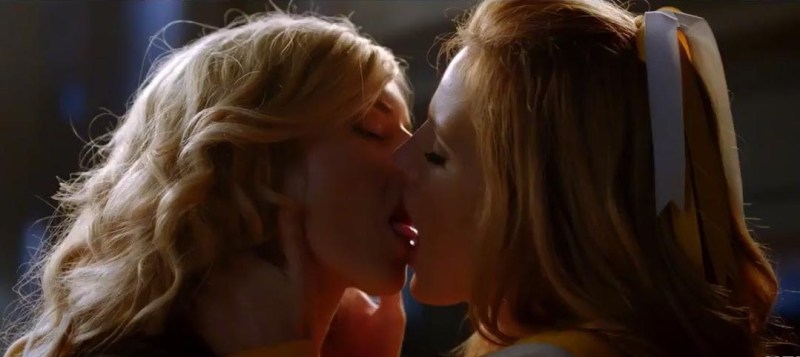
Here’s another slight stretch, but I’m nothing if not thorough. Horror-romp The Babysitter‘s only Queerleading-adjacent moment comes when Samara Weaving’s Bee tongues Bella Thorne’s Allison during a game of spin the bottle. Allison is in her cheerleading uniform for the purposefully over-the-top make out sequence, during which Bee puts her gum in Allison’s mouth???? There’s no overt textual evidence of Allison’s bisexuality or queerness in the film — unless you count her very apparent arousal during this extended kiss, WHICH I DO??? Plus, I feel like every Bella Thorne character just radiates Bella’s own bisexuality.
We do see this slow-motion scene unfold from the perspective of an adolescent boy, so I can see how it might be viewed as a continuation of the sort of male fantasy of Queerleaders from back in those 70s movies or in modern-day porn. But the scene is also so long and so exaggerated that it actually feels like its poking fun at the voyeur and quite LITERALLY being tongue-in-cheek.
Dare Me (2019)
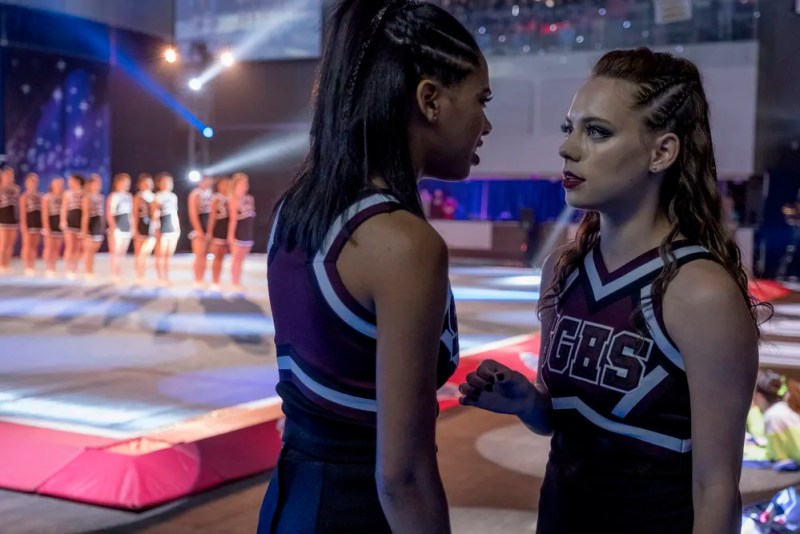
Yay, I get to now participate in one of my favorite hobbies: Screaming at people to watch Dare Me.
WATCH DARE ME!
No movie or show has captured the baked-in brutality of cheerleading as a sport as searingly as Dare Me, a slow-burn thriller full of blood, crunched bones, and contorted bodies. It also lives in another hyperspecific subgenre I’m drawn to: stories about toxic mentorship. In this instance, that takes the shape of a really fucked up coach-athlete dynamic. It doesn’t go the ways you think it might. But coach Colette French’s (Willa Fitzgerald) need for total control over the body and mind of Addy Hanlon (Herizen F. Guardiola) and the ways she manipulates the young girl are a true source of horror.
And that violent power dynamic never becomes overtly sexual, because queerness itself isn’t villainized in Dare Me — abuse of power is. Instead, there’s a slow-burn queer romance at the core of the show, sizzling just on the sidelines for much of the series. but ultimately hugely important for character motivation and development. Addy’s co-dependent friendship with bff Beth (Marlo Kelly) is gradually revealed to be something more. The subtext becomes bolder text in measured, scintillating increments rather than some gaudy big reveal, and it feels all the more real for that. And throughout, Dare Me explores just how dangerous and intense cheerleading itself can be, sticking up its middle finger to portrayals of the sport as something cute and fluffy. Femininity in Dare Me has sharp edges and bite.
I recently read the pilot script for Dare Me and was struck by some of the language it uses in its descriptions of actions. It describes the girls putting glitter on their faces as putting on their “cheer masks.” When a character falls, the script notes that this is what cheering really is. Here is a show that understands well the performance, risk, and almost battle-like stakes of cheerleading, which makes its exploration of Queerleading all the juicier.
Knives and Skin (2019)
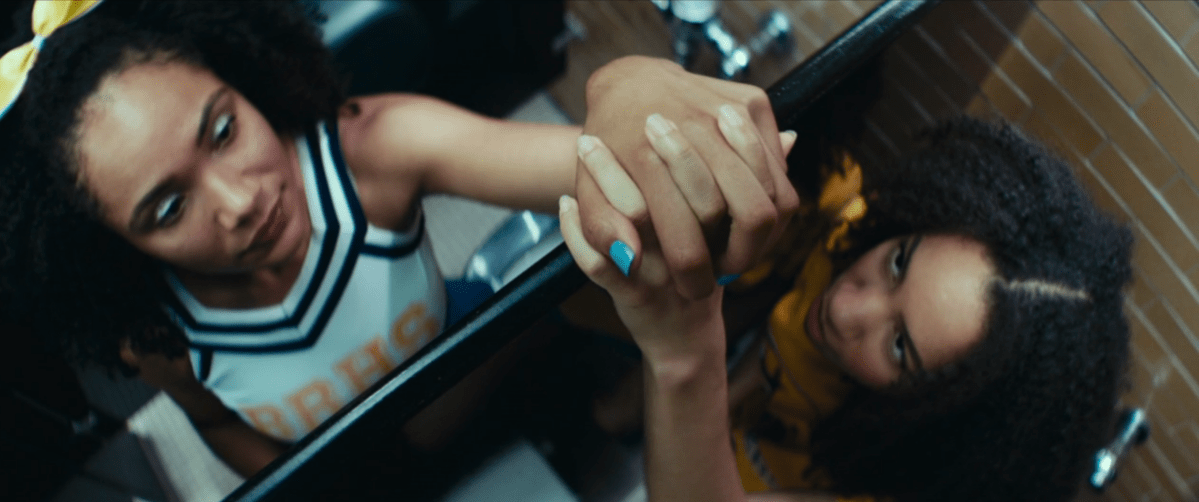
A surreal psychological thriller that has been described as like if David Lynch made a teen movie without ever really living up to that admittedly alluring interpretation, Knives and Skin is a very strange movie that includes clownfucking, haunting a cappella renditions of pop songs, and strong use of color. For an experimental film, it just doesn’t quite take enough risks and could also have done with a tighter edit.
One of its many teen girl characters (the movie is largely about, among other things, the unbearable sadness threaded through girlhood) is a Queerleader named Laurel (Kayla Carter). Presumably, she’s in the closet or otherwise still figuring out her sexuality. She’s in a highly visible relationship with a boy but a shadow relationship with another girl. Even if they never officially “date,” they find a lot of homoerotic things to do together, including passing handwritten notes to each other that were kept…inside their vaginas.
The Prom (2020)
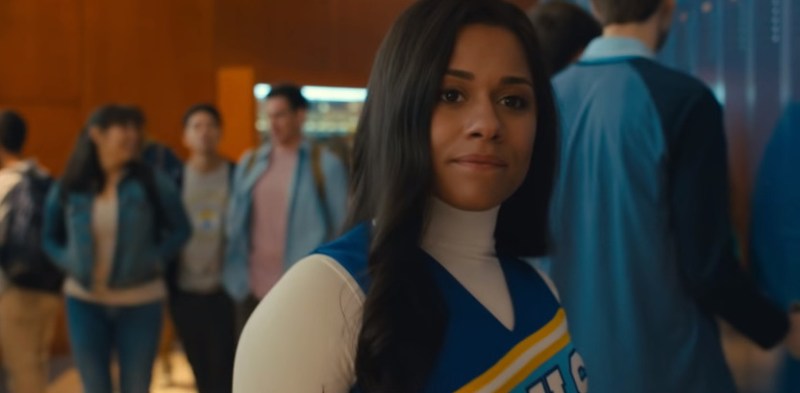
Ariana DeBose’s closeted Queerleader Alyssa is easily the best part of The Prom, a movie musical I wish I liked more! It is very heartwarming and lovely in moments, but there’s an emptiness to it that makes it almost instantly forgettable. But! Alyssa! Alyssa is a great character, and her relationship with her queerness is different than that of the film’s main character. The stakes are different for her.
Alyssa’s solo in the movie “Alyssa Greene” is all about her mother’s (Kerry Washington) molding of her into a perfect girl. She has to be beautiful and smart (“The hair has to be perfect / The As have to be straight”). She has to be the best at everything she does (“Trophies have to be first place / Ribbons have to be blue”). Cheerleading is one of the many things Alyssa has to ascribe to in order to achieve the level of perfection her mother demands and the level of perfection that ultimately buries her queerness deeper and deeper. It’s a tactic a lot of queer folks employed in our teenage years, myself included: You think there’s something “wrong” with you so you fight like hell to make everyone else see “perfection.” Her cheerleading uniform is like the rest of her life: a costume and an act. Or, maybe, armor to protect herself.
The music video for “Cheerleader” by Sir Babygirl (2020)
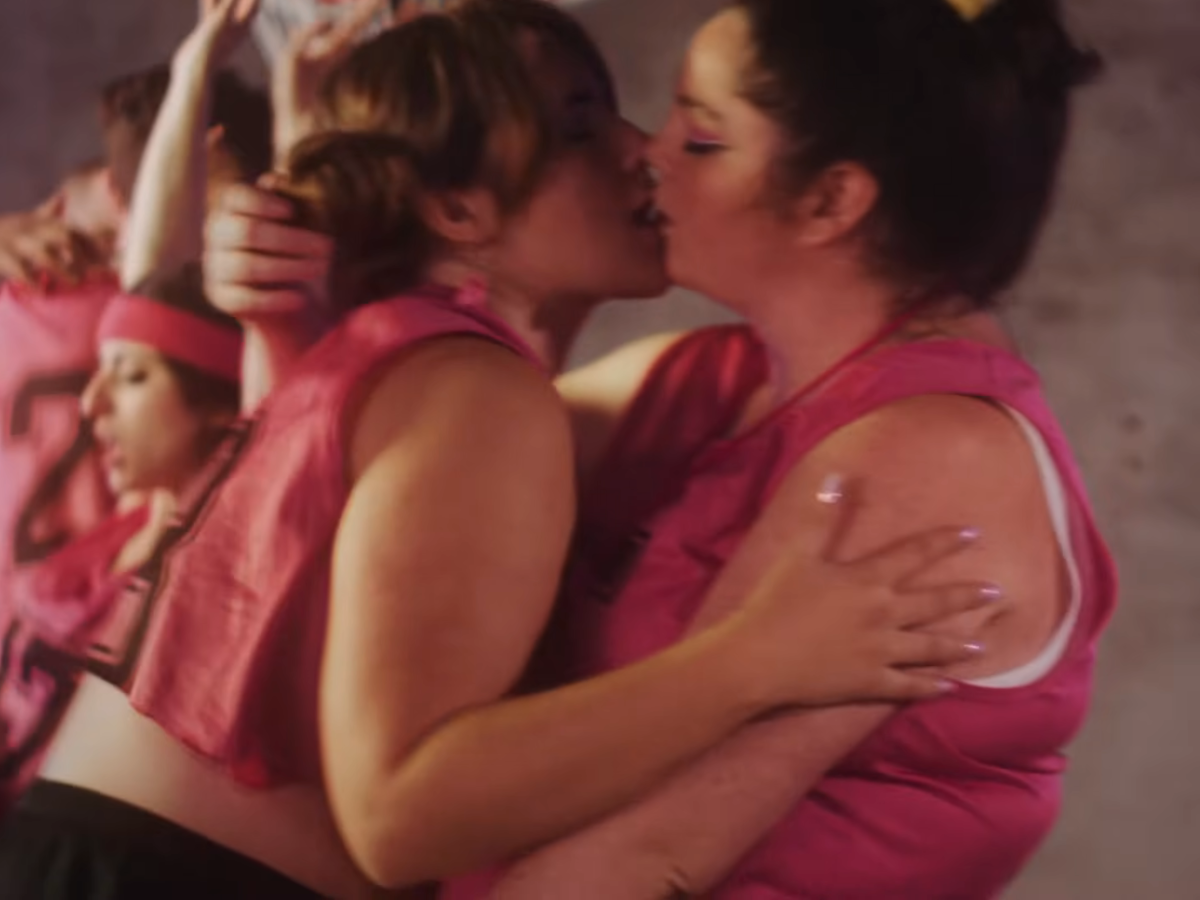
Queerleading-themed music videos have become a very specific canon of art, so while they technically fall outside of the realm of movies and television, I have now encountered so many that I feel they undoubtedly belong on this list.
In this example from nonbinary pop singer Sir Babygirl, the Queerleader is present in both the text of the song and its visual accompaniment — a true delight of a music video in which cheerleaders of all genders and body types lust for each other in the locker room and beyond. “Everybody wants to watch the cheerleader,” Sir Babygirl sings over it, which is basically one of the theses of this piece.
My favorite thing about this music video, though, is that queer comedic genius-freak Meg Stalter is in it as one of the many Queerleaders!
Fear Street Part One: 1994 (2021)
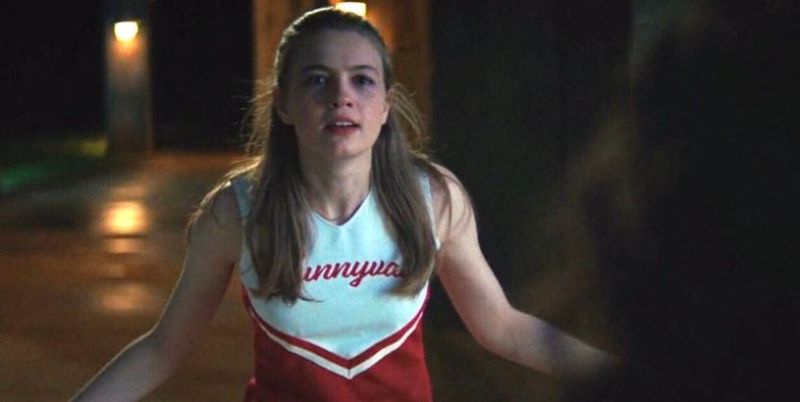
I find Sam to frankly be the least interesting character in the Fear Street trilogy, but she is a Queerleader! We first meet Sam (Olivia Scott Welch) in the first installment. She’s in her cheerleading uniform on the football field at Sunnyvale High, where she has recently transferred from Shadyside. Up to this point, we know protagonist Deena (Kiana Madeira) is going through a dramatic high school breakup, but we don’t know it’s of the queer variety until this moment, Sam finally dropping the facade of her picturesque performance, wrapped in the arms of a football player, to have a full-on dyke fight away from everyone else with Deena. Sam’s clearly going through it, thinking that the only way she can have a happy and healthy life is to become this textbook, idealized cheerleader-dating-a-football-player high school trope. And frankly I think Deena should let Sam figure that out on her own and date someone more secure, but teens will be teens!
The music videos for “Somebody I Fucked Once” by Zolita and “Silk Chiffon” by MUNA and Phoebe Bridgers (2021)
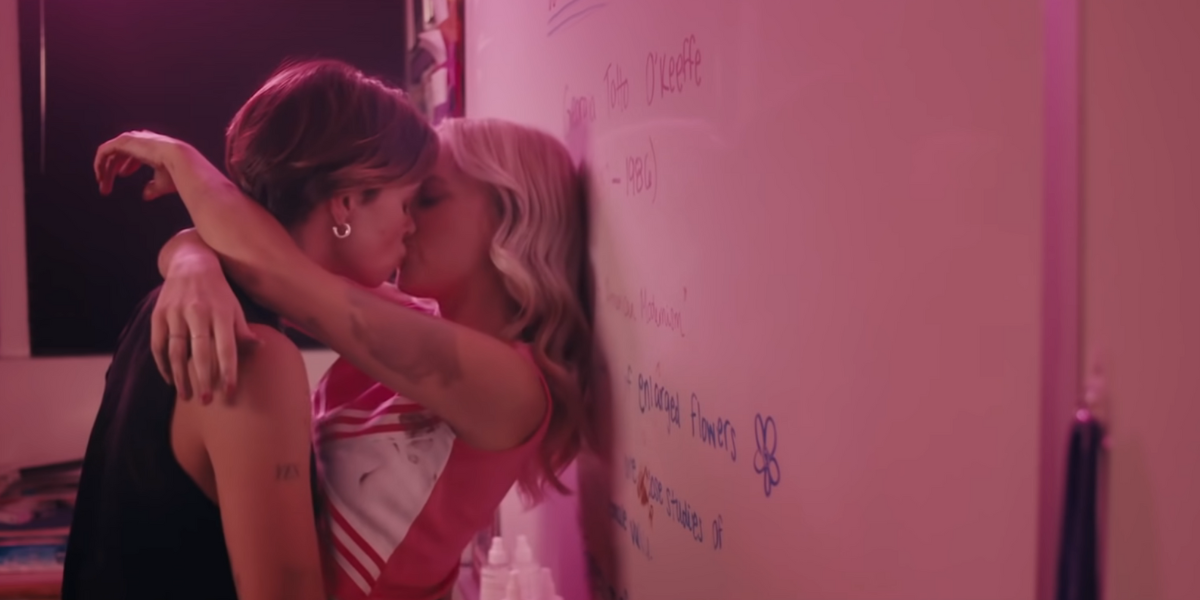
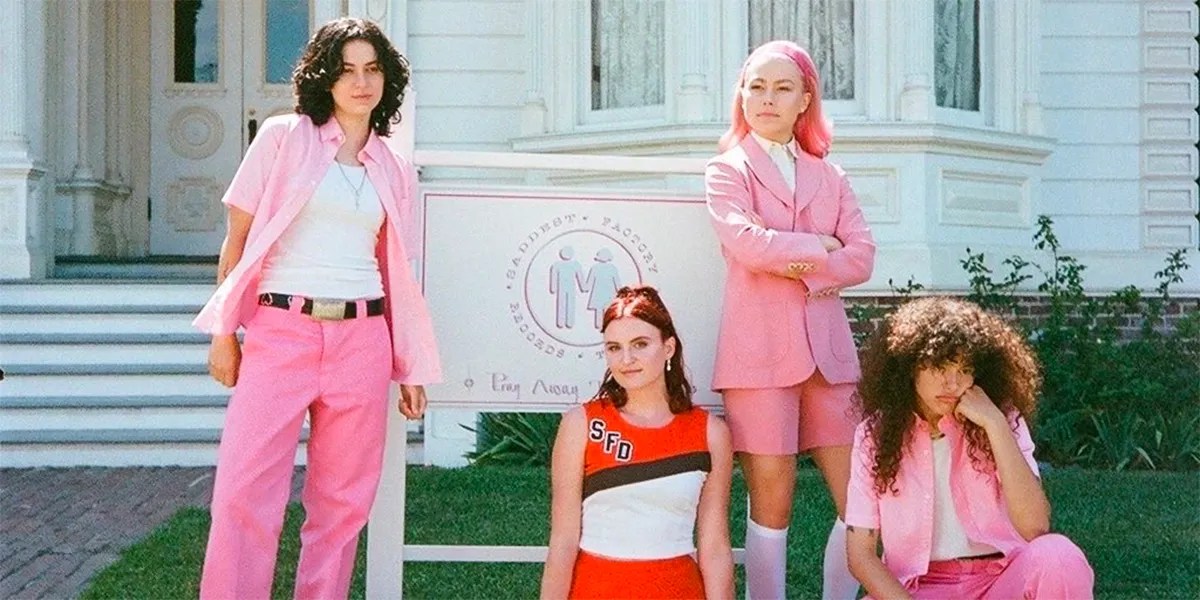
Two Queerleader music videos came out in 2021.
MUNA’s “Silk Chiffon” directly references and reproduces images and storylines from But I’m a Cheerleader, a cute and fun tribute that feels fitting for the bubbly queer love pop song that seemed inescapable the summer it debuted. Phoebe Bridgers also appears in the tribute.
Zolita’s take for “Somebody I Fucked Once” is arguably the campier video of the two. It’s less of a straight riff and more like a mix-and-match collage of early 2000s aesthetics, teen movie tropes, and Queerleader imagery! In it, the blonde, pink-clad cheerleader falls for the goth brunette who’s into pottery. Yes, there is a sensual pottery wheel moment! Simply put, this is the hornier of the two music videos, still bubblegum pink and corny throughout but with more teeth to it.
The main reason I wanted to include the Zolita music video is because I feel like it’s ultimately doing the same work I set out to do with this list by paying tribute to the Queerleader and recognizing her stronghold in lesbian pop culture in a way that acknowledges that, yes, some of us queer women do indeed find the mere concept of Queerleaders very sexy! The Queerleader as an erotic image does not solely belong to the realm of male fantasy. This music video gets that in the same way the scene from Wynonna Earp does.
Bring It On: Cheer or Die (2022)
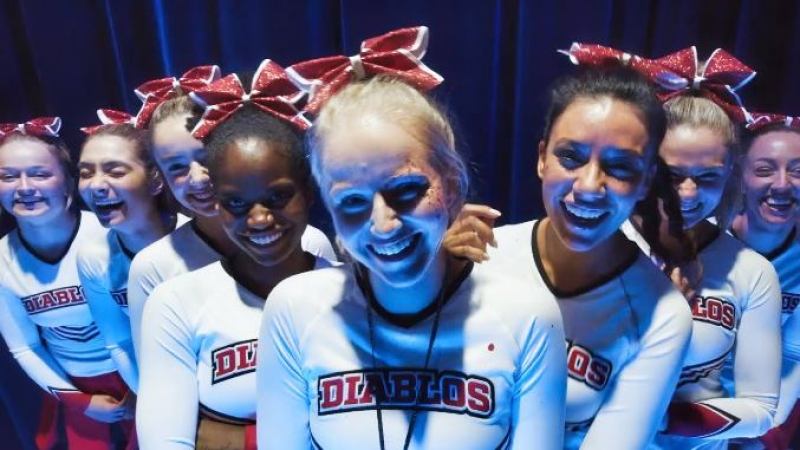
This made-for-TV entry in the Bring It On universe is not very good, despite having a solid hook (a cheerleading slasher) and being the first of ANY of the Bring It On movies to be directed by a woman (how!!!!). I did say going into it “if this movie doesn’t have a Queerleader, I’m rioting.” Thankfully, it does technically deliver, even if it’s only in the most minuscule way, near the end of the movie. But sure enough, one of the members of this cheer squad harbors a secret crush on a fellow cheerleader, and instead of leaning into the predatory vibes the way Fired Up! does, we get something much more sincere and sweet. Also, as far as slashers go, I didn’t hate the killer reveal here. But no, it’s not a very good movie, so consider yourself warned. Now, someone let me write Bring It On: Queerleaders Rise.
The music videos for “Cheerleader” by Ashnikko and “Cheerleader” by Liza Anne (2023)
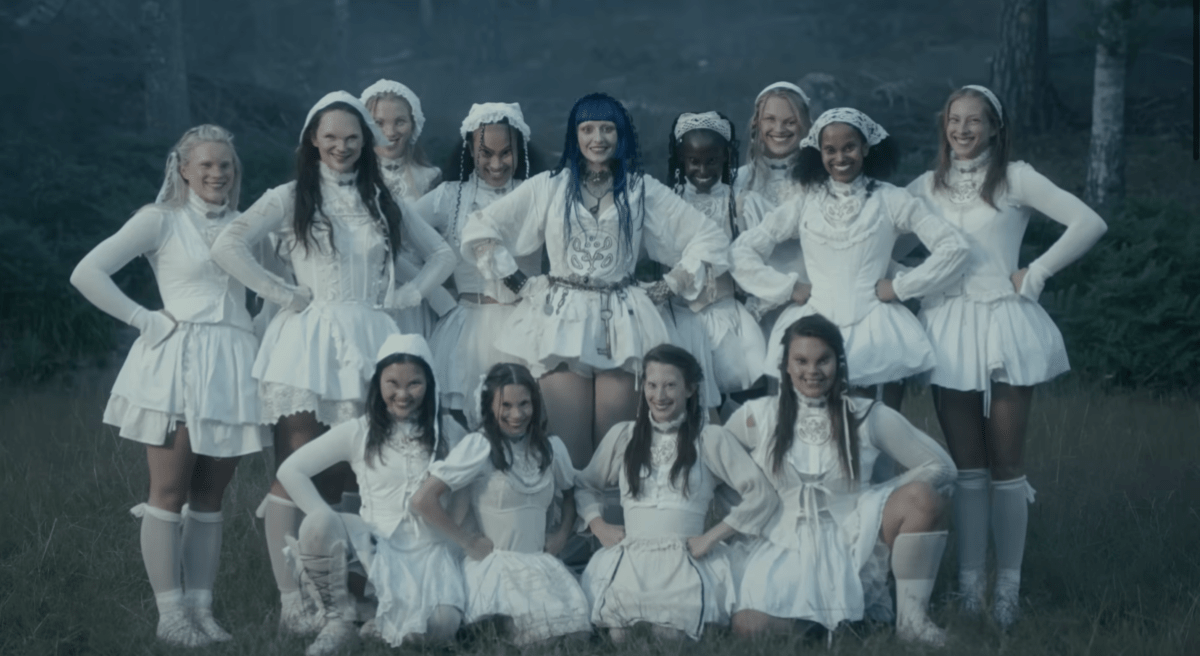
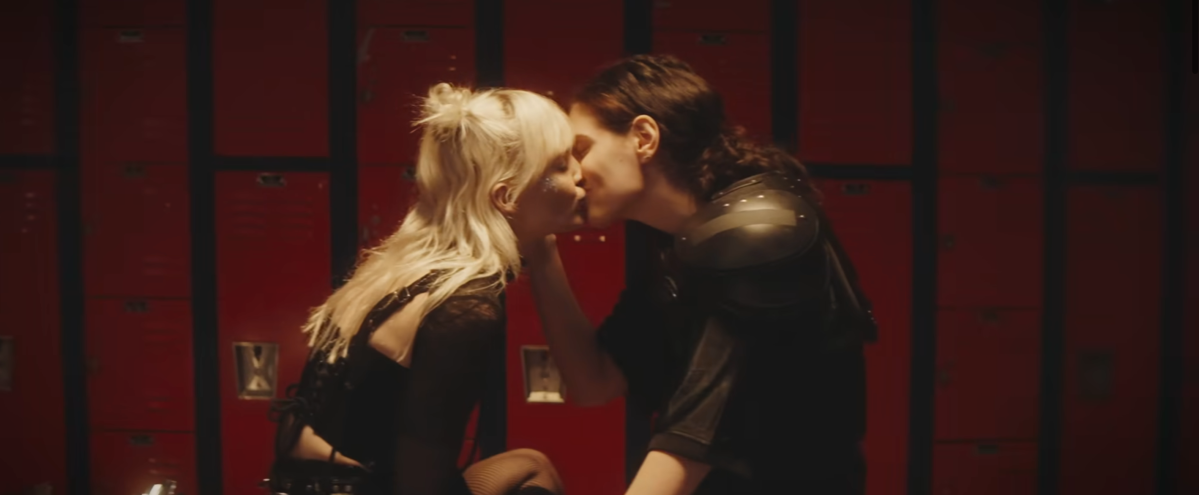
There are so many songs called “Cheerleader” out there by queer and trans artists! A specific sub-trend I found within this overall specific media trend.
Pansexual and genderfluid artist Ashnikko’s song “Cheerleader” makes direct references to the movie Bring It On, but the music video is decidedly more horror-leaning. In it, demonic cheerleaders do routines in the woods. The song is steeped in themes of beauty standards and gendered expectations. The music video is a Queerleader Nightmarescape.
Gay and nonbinary musician Liza Anne also has a “Cheerleader” song with a very gay music video to match. Queer makeouts happen in the locker room, in the stadium stands, and on the football field. The video recreates classic high school tropes with queer and punk aesthetics. I love that this entry also continues the niche trend of “Queerleader music videos starring queer alt comedians” established by Sir Babygirl — that’s Eva Victor making out with Liza Anne the whole time!
Bottoms (2023)
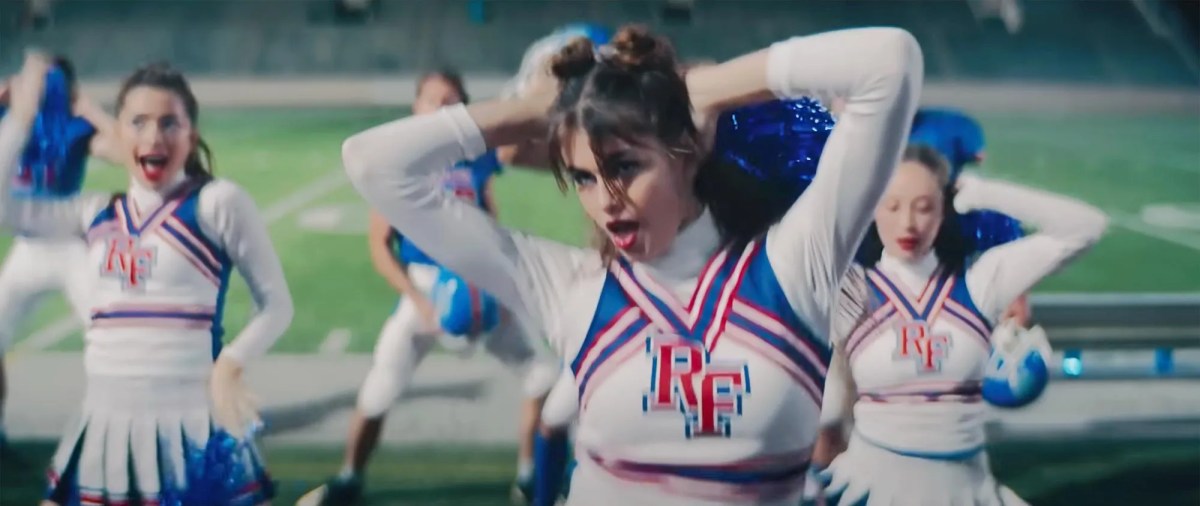
Ah, yes, my personal movie of the summer for 2023. My Queerleader north star. The feature film Bottoms.
Directed by Emma Seligman, Bottoms is the latest Queerleader movie to grace our timeline, and it is quite the gem! In it, best friends Josie (Ayo Edebiri) and PJ (Rachel Sennot, who co-wrote the movie with Seligman) start a fight club at their high school in order to woo hot cheerleaders Isabel (Havana Rose Liu) and Brittany (Kaia Gerber) into getting physical with them.
I found myself often thinking about 2009’s Fired Up! while watching the movie, as both belong to the genre of raunchy teen comedy. Whereas teen straight boys pretend to be cheerleaders in that movie in order to up their body count, here we have a movie about teen lesbians pretending to have gone to juvie and know how to fight in order to up their body count. Whereas the only lesbian or lesbian-coded character in that movie is very minor and is portrayed as a joke and a creep, here we have two lesbian protagonists whose queerness isn’t a joke but who are, indeed, kind of creeps! I think this comparison and deep dive into contextualizing Bottoms within the history of teen sex comedies rendering lesbians as predators deserves an entire separate essay from this timeline (at some point, I imagine there being an Appendix to this article). But what I’ll say for now is that while it might be controversial for some, I am delighted by the ways Bottoms doesn’t eschew those damaging tropes we see crop up in a movie like Fired Up! but rather lean in to the idea of manipulative queer teens and yet in a way that doesn’t ultimately feel homophobic but rather just true to horndog teenagehood in general.
During my research, I did not encounter any specifically trans representations of Queerleaders outside of the music videos, suggesting that even queer representations of cheerleaders come with rigid assumptions about gender, girlhood, and who gets to be a cheerleader. This was a disappointing finding. I’m glad music videos, at least, are holding it down for nonbinary and trans interpretations and visualizations of the trope.
Clearly, the Queerleader isn’t going anywhere — the character’s appeal is vast and lasting. Some stories use her to reinforce social rules and roles, some to subvert them. The built-in homoerotics of the sport makes it a terrific playground for lesbian activity, but it’s also the sheer position of the cheerleader as this mythical symbol of perfection and heightened femininity that makes it so enticing to inject queerness. The Queerleader is much more than a sex symbol, but at the same time, the character’s potential for distinctly lesbian erotics cannot be denied!
If you think there’s anything I’ve missed, please let me know! I love an excuse to watch Queerleading movies for my job, and as I’ve demonstrated, I want this to be as comprehensive as possible! I know cheerleading is distinctly American but any international movies I should check out? Let me know!



Aaaahhh!! I absolutely love this. Reading it brought me so much joy: I’m so here for queer media textual analysis that may or may not cross the line into full on academia. And I’m now I’m super excited about Backspot and Bottoms – and to read your thoughts on them when they come out! (Pun not intended!)
thank you! I’m sure they’ll get full separate reviews and then be added to this!
If you’re open to things in the musical realm, you should check out the album “Death of a Cheerleader” by the band Pom Pom Squad! The lead singer has talked all about how she wanted to play with the cultural role of the cheerleader as a queer woman of color. The theme is all over the music videos and she even performs dressed as a cheerleader sometimes. Imo the whole album is a queer collage of repurposed pop culture references collaged back together in a very queer way…..and it’s great music, too! Thanks for writing this, very interesting and gave me some new media to check out.
whoa this sounds extremely cool and relevant to this project!
Dug around and found this interview where she talks about it a lot! https://www.rollingstone.com/music/music-features/pom-pom-squad-death-cheerleader-interview-1189315/
thank you!!
Kayla I IMMEDIATELY texted my husband that we must watch All Cheerleaders Die, thank you for bringing up this important and very wild topic. And always: Justice for Jennifers Body
it’s a fun one!
I was prepared to put a video of “I Want to Hold Your Hand” in the comments because I figured nobody would know/remember poor little Prudence. How delighted I was to see her not just already there, but near the top.
hahahaha i really wanted to try as hard as possible to not miss anyone!
this is so thorough and complex and fun and i love it so much!
“it’s actually this sort of casual representation of the lesbian as inherently creepy and aggressive within feminine spaces that did way more psychic damage on me than any overt examples of the lesbian as a villain or even as a killer”
this is so true!! i am finding often when i re-watch movies & shows from the 90s they have queer characters i don’t even remember existing but they’re all these sort of bit parts of predatory lesbians who made me think lesbians were gross.
thank youuuuuuu. and yes 90s and early 2000s were like a truly atrocious time for like the lesbian-coded/lesbian-implied side character who’s “creepy.” which to ME is more harmful (and in a lasting way!) than something like Basic Instinct which is a genuinely good movie lol
This is terrific!
Btw if you’re still looking for a trans queerleader, try the graphic novel Cheer Up!: Love and Pompoms by Crystal Frasier and Val Wise
Yes! Casey has rec’d that book in a few different pieces on the site. It looks great, I just didn’t want to go to far down a literature path because I feel like that could be its whole own thing.
I have never seen cheerleaders in action although I have of course heard if them. Love the article. Now I have to find out what it is all about..
This is so great! Growing up in the UK, where we don’t have cheerleading in school, I was always enamoured with the cheerleaders on American shows. She’s sadly not queer but she was “different” so I was very into Peyton on One Tree Hill. But mainly I came here to say that there is trans cheerleader representation in the musical version of Bring It On (which is actually loosely based on Bring It On 3, randomly). It’s not been made into a film yet but it’s a Lin-Manuel Miranda vehicle so there’s always a shot!
i’ll check it out!
WHAT WHAT WHAT “i want to hold your hand?!?!?!” how did i not know about this??? i think i would have imploded if i saw that in 2007.
the way i forced my friends to watch that movie at every sleepover for MONTHS lol……
sooo great love this article so much
thank you! it took a LOT of time so thank you for being an A+ member bc truly it supports work like this!!!
Kayla this is such excellent scholarship. I greatly appreciated the historical research and context and Backspot? Bottoms?? I need these to be made. I know this took a seriously long time to put together but what a seminal work of Autostraddle writing.
thank you Nico!!!!! truly cannot wait for Backspot and Bottoms
This is so, so, so good. Holy moly.
thank you so much Niko!!!!
You forgot Tea from Skins US. But to be fair, forgetting about Skins US is probably for the best. :p
I truly could not get through Skins US :\
This is AMAZING! Thanks for this collection and fabulous write up, Kayla! I’ve got some new items to add to my to-watch list :)
Also another Queerleader I’d like to add to the list is Waverly Earp from the TV show Wynonna Earp (the routine she does for Nicole is perfection).
you are CORRECT and it was accidental! i’ve seen the show! i just forgot! but this is actually a very important one so I think I’m going to go ahead and add it now! thank you!
added!!
Ahhh SO COOL!! Thank you! Appreciate you and all that you do for Autostraddle! :)
As a former pom squad captain, I appreciate this research and analysis.
i truly love how many people have been coming out (hehe) as former cheerleaders to me
What about Paige from Degrassi Next Generation? Her enemies to lovers relationship with Alex was the blueprint for Cheryl/ Toni. Very underrated couple that didn’t get the respect they deserved.
will investigate!
ok yes i will be adding Paige!
ADDED
Thank you for this excellent summary! I’m gonna go read some fic and keep thinking her and Alex eventually ended up together somehow.
I really have to watch Dare Me!! I read the book it’s based on years ago and it is also excellent. Highly recommended!
Megan Abbott doesn’t miss imo!! And she was directly involved with the adaptation
this was so GOOD thank you for this scholarship!! i ALSO was not allowed to be a cheerleader because it was “too dangerous” and i really think i missed out!
I am very confident we both would have been GREAT QUEERLEADERS!!!!
thank you thank you for this incredibly thorough and well written analysis ! really stoked for the upcoming 2 queerleader movies and to hear more of your thoughts!
was just thinking – darby and the dead does have a trans cheerleader (piper played by nicole maines); she isn’t a main character but will be interesting to see how gen Z and future generations continue to queer the cheer archetype.
Will watch Darby and the Dead!
Incredible scholarship!
Ethel Cain in the American Teenager music video is the only trans cheerleader who comes to mind for me.
Unlikely that you’ve missed any European films I think, since cheerleading is not a cultural touchstone here like it is in the US. Though your ‘thesis’ did really make me think of Celine Sciamma’s Water Lilies. The central sport is synchronised swimming not cheer, but it explores the same dichotomies of a historically ultra ‘feminine’ pursuit (intensely athletic but seen as shallow, simultaneously sexless and fetishised under the male gaze) with a queer coming of age slant.
Oooh good call on Water Lilies!
Yeah this is a really good point re:Water Lillies! I think it’s totally an extension of a lot of the things I’m taking about here
If you’re at all into musicals, I highly recommend We are the tigers! It actually follows through on the promise of a cheerleading slasher while also being quite queer (with a somewhat strange fandom on tumblr). It’s got a great original cast and soundtrack, and got me through an entire year.
I have been curious about this musical ever since A. Tony wrote it into this: https://www.autostraddle.com/which-horror-musical-are-you/
i also came to the comments to say this! also, if we’re talking Bring It On and lesbian subtext, it’s practically dripping off the two main characters of the stage musical adaptation (and, separately, there’s a trans cheerleader character!)
yeah i’ve heard good things about the stage adaptation!
Kayla, can’t wait to cite this article as a source in conversation. A+ work!
Ahhhh thank you!!!
I saw Bring it On for the first time when I was 10 and it just absolutely had me enthralled from the first scene. Even now I think it’s a near-perfect movie. The depiction of race/class is chefs fucking kiss and contemporary efforts to explain such things in the clumsy and patronising manner of an Instagram infographic should take a leaf out of Bring it Ons book.
I have seen some…wild Bring It On takes! especially when working on this piece
Oooh I am SO interested in reading said takes! Some links please?
Thank you!! This is the kind of content I come to autostraddle for and I will be watching the movies I haven’t seen on this list(maybe even the incredible ones)
Other thoughts: still very mad about Dare Me being cancelled. A travesty.
Eliza Dushku was a big part of my queer awakening – in general and also in Bring it On. Would love a picture of Missy (also Torrence x Missy should have been the love story in that film)
Let me know what you think about any of the movies you end up watching! It’s a real mixed bag here in terms of quality haha but they’re all fun in their own ways
I had pizza for dinner last night and greatly appreciate versatile toppings.
Just… in case it matters to someone: You seemed to kind-of apologize for an academic tone in the first half of this, but I would gladly read the crap out of scholarly articles in Autostraddle. This was just gorgeous. Thank you.
haha thank you for this validation!
co-signed!
This piece is amazing!!!! What a fantastic scholarly and sexy exploration of gender and sexual orientation in an extremely American cultural institution! I felt like I was in college again in a women’s studies class but having way more fun than usual! Note: college was 1988-1991 for me so not yet gender studies and not much lesbian scholarly content.
What I am really eager to say is that this reminded me of a significant lesbian moment in 11th grade when I was wrestling with my lesbian feelings towards several different girls: my best friend, an acquaintance, an out bi classmate who was pursuing me, a popular girl in my classes, a mean and scary jock and NOW member in my classes, and probably several dozen more on and unconscious level.
One day in art we were drawing each other and a cheerleader and I were assigned to each other. I was so scared of her! I felt sure she would think I was gross for being queer if she figured it out! I still feel that way, especially about cheerleaders because they are the pinnacle of mean powerful feminine straightness!!!! Like the judges of normal! With the power to destroy other girls using homophobia!!!
Anyway, after drawing me, she said I have no upper lip at all and a HUGE lower lip (her exact words, and not very accurate; I have very thin lips). I was stricken in fear that she would call me a freak! But later, she WINKED at me.
WHAT DID THAT MEAN????????????? I think I obsessed over every possible meaning of that wink for years!
THUS IS THE POWER OF THE CHEERLEADER.
Oh, also: I would read an entire book about this. Please write it.
!!!!! i do feel like a book could easily be written about like this and other recurring lesbian/bisexual character stocktypes from pop culture
Totally! Kind of like Tomboy but about real life dykes interacting with real life and fictional archetypes. Maybe a series! Like Chicken Soup for the Lesbians!
Another excellent music video is Sir Babygirl’s Cheerleader: https://www.youtube.com/watch?v=d6n-NoGfCrY
(and just in general more people should know about Sir Babygirl!)
Also, I wonder if there’s a similar trend to be found in gymnastics movies. I definitely felt the queer subtext of 2006’s Stick It, even if I didn’t recognize it as such at the time.
wowoowow YES how could I forget?!?! big Meg Stalter fan and she’s in that vid!
Cheer Up: Love And Pom Poms is a cute comic about a romance between a kind trans cheerleader and a grumpy lesbian who reluctantly joins the squad. The other girls on the cheer team have to learn to stop treating the trans girl as a mascot. It’s fun and quite well done.
Lost Girl has two queerleaders. Badass bisexual valkyrie Tamsin has to go undercover as a cheerleader. Her partner Dyson thinks there’s no way she can pull it off. Tamsin replies, ” Gimme a D, gimme a Y, give me a suck my balls.” Tamsin does a bunch of cool flips and handsprings and wears a cheerleader outfit (probably the point of the episode). Tamsin dismisses the real cheerleaders and expects them to be in love with the quarter back. But they care more about their careers. Tamsin The one male cheerleader is actually dating the quarterback.
Some books I haven’t read: She Drives Me Crazy by Kelly Quindlen, Homefield Advantage by Dahlia Adler, Say Yes To The Cheerleader by Abby Crofton, and Cheerleaders From Planet X by Lyssa Chiavari.
omg i forgot about that ep of Lost Girl!!!
Homefield Advantage is super cute and I would absolutely recommend it. The fact that it’s based on a true story is a cherry on top.
Two more books I haven’t read: Style by Chelsea M. Cameron and Exit, Pursued By a Bear by E.K. Johnston.
Also, love this article! It’s very entertaining and thorough.
Thanks for this list, and great to see Dare Me getting some love.
Also, the main characters from Tragedy Girls are cheerleaders. It’s debatable whether it’s queer or subtexty, but the combined queerness of the main actors makes the whole thing feel pretty gay.
oh yes that movie FELT so gay even if it wasn’t completely textual
“Reference work can be horny, too” – and how! Top-notch research here, absolutely loved it.
ty! hoping to bring more horny research to Autostraddle soon!
Terrific article! At the end you mentioned that you’d yet to encounter any trans representations of cheerleaders. I’d like to recommend ‘Darby and The Dead’ (2022), which has Nicole Maines as a transwoman cheerleader.
And another vote for Pom Pom Squad as a great band.
I dated a cheerleader in high school & it was SUCH a harrowing, bizarro queer teen girl experience that this masterpost is bringing me back to being at football games that I did not give a shit about. And what a masterpost!
This article (update) feels so timely with Devery Jacobs’ film coming out at TIFF, backspot. Can’t wait for that one- sounds like it’ll be in the dare me genre
but… but… the buffy the vampire slayer movie
🥺
👉👈
Abby Suso from Love, Simon is a bi cheerleader. In the movie there’s only a couple of looks between her and Leah suggesting their attraction, but in the books Abby and Leah both come out as bi and are girlfriends.